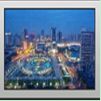Gallery结合案例详解
Gallery(相册)控件是个很不错的图片查看控件,屏幕中有一个图片列表,Gallery类的继承关系如下:
java.lang.Object
↳ android.view.View
↳ android.view.ViewGroup
↳ android.widget.AdapterView<T extends android.widget.Adapter>
↳ android.widget.AbsSpinner
↳ android.widget.Gallery
这个Gallery案例,可以用手滑动Gallery,当用户点击某个图片弹出一个Toast,如6-11图:

6-11 Gallery控件使用效果图
程序代码请参考代码清单6-9:
【代码清单6-9】 chapter6_5/src/com/work/GalleryActivity.java
public class GalleryActivity extends Activity {
@Override
public void onCreate(Bundle savedInstanceState) {
super.onCreate(savedInstanceState);
setContentView(R.layout.main);
Gallery g = (Gallery) findViewById(R.id.gallery);
g.setAdapter(new ImageAdapter(this));
g.setOnItemClickListener(new OnItemClickListener() {
public void onItemClick(AdapterView parent, View v, int position, long id) {
Toast.makeText(GalleryActivity.this, "" + position, Toast.LENGTH_SHORT).show();
}
});
registerForContextMenu(g);
}
@Override
public void onCreateContextMenu(ContextMenu menu, View v, ContextMenuInfo menuInfo) {
menu.add(R.string.gallerytext);
}
@Override
public boolean onContextItemSelected(MenuItem item) {
AdapterContextMenuInfo info = (AdapterContextMenuInfo) item.getMenuInfo();
Toast.makeText(this, "Longpress: " + info.position, Toast.LENGTH_SHORT).show();
return true;
}
public class ImageAdapter extends BaseAdapter {
int mGalleryItemBackground;
public ImageAdapter(Context c) {
mContext = c;
TypedArray a = obtainStyledAttributes(R.styleable.Gallery1);
mGalleryItemBackground = a.getResourceId(
R.styleable.Gallery1_android_galleryItemBackground, 0);
a.recycle();
}
public int getCount() {
return mImageIds.length;
}
public Object getItem(int position) {
return position;
}
public long getItemId(int position) {
return position;
}
public View getView(int position, View convertView, ViewGroup parent) {
ImageView imageView;
imageView = new ImageView(mContext);
imageView.setImageResource(mImageIds[position]); //此处要是gallery循环这几个图像,可以使用取余的方法来循环取这个数组的值 :imageView.setimageResource( mImageIds[position% mImageIds.length]); position设为Integer.MAX_VALUE
java.lang.Object
↳ android.view.View
↳ android.view.ViewGroup
↳ android.widget.AdapterView<T extends android.widget.Adapter>
↳ android.widget.AbsSpinner
↳ android.widget.Gallery
这个Gallery案例,可以用手滑动Gallery,当用户点击某个图片弹出一个Toast,如6-11图:

6-11 Gallery控件使用效果图
程序代码请参考代码清单6-9:
【代码清单6-9】 chapter6_5/src/com/work/GalleryActivity.java
public class GalleryActivity extends Activity {
@Override
public void onCreate(Bundle savedInstanceState) {
super.onCreate(savedInstanceState);
setContentView(R.layout.main);
Gallery g = (Gallery) findViewById(R.id.gallery);
g.setAdapter(new ImageAdapter(this));
g.setOnItemClickListener(new OnItemClickListener() {
public void onItemClick(AdapterView parent, View v, int position, long id) {
Toast.makeText(GalleryActivity.this, "" + position, Toast.LENGTH_SHORT).show();
}
});
registerForContextMenu(g);
}
@Override
public void onCreateContextMenu(ContextMenu menu, View v, ContextMenuInfo menuInfo) {
menu.add(R.string.gallerytext);
}
@Override
public boolean onContextItemSelected(MenuItem item) {
AdapterContextMenuInfo info = (AdapterContextMenuInfo) item.getMenuInfo();
Toast.makeText(this, "Longpress: " + info.position, Toast.LENGTH_SHORT).show();
return true;
}
public class ImageAdapter extends BaseAdapter {
int mGalleryItemBackground;
public ImageAdapter(Context c) {
mContext = c;
TypedArray a = obtainStyledAttributes(R.styleable.Gallery1);
mGalleryItemBackground = a.getResourceId(
R.styleable.Gallery1_android_galleryItemBackground, 0);
a.recycle();
}
public int getCount() {
return mImageIds.length;
}
public Object getItem(int position) {
return position;
}
public long getItemId(int position) {
return position;
}
public View getView(int position, View convertView, ViewGroup parent) {
ImageView imageView;
imageView = new ImageView(mContext);
imageView.setImageResource(mImageIds[position]); //此处要是gallery循环这几个图像,可以使用取余的方法来循环取这个数组的值 :imageView.setimageResource( mImageIds[position% mImageIds.length]); position设为Integer.MAX_VALUE
imageView.setScaleType(ImageView.ScaleType.FIT_XY);
imageView.setLayoutParams(new Gallery.LayoutParams(136, 88));
imageView.setBackgroundResource(mGalleryItemBackground);
return imageView;
}
private Context mContext;
private Integer[] mImageIds = {
R.drawable.beijing,
R.drawable.changsha,
R.drawable.chengdu,
R.drawable.chongqing,
R.drawable.haerbing,
R.drawable.jinan,
R.drawable.jiujiang,
R.drawable.kunming,
R.drawable.nanjing
};
}
}
代码的关键的地方是实现BaseAdapter适配器类——ImageAdapter,其中关键是getView()实现。在convertView为null时候实例化控件,imageView.setLayoutParams(new GridView.LayoutParams(136, 88)是设置一个单元格中图片的大小是136×88像素。imageView.setScaleType(ImageView.ScaleType.FIT_XY) 缩放图片使用FILL方式。imageView.setImageResource(mImageIds[position])为图片控件设置图片。
在布局文件/chapter6_5/res/layout/main.xml中添加Gallery控件:
<?xml version="1.0" encoding="utf-8"?>
<Gallery xmlns:android="http://schemas.android.com/apk/res/android" android:id="@+id/gallery"
android:layout_width="match_parent"
android:layout_height="wrap_content"
/>
本例中设置图片的背景样式是边框样式,如图6-12。

图6-12 图片背景样式
imageView.setBackgroundResource(mGalleryItemBackground)语句就是设定样式的,成员变量mGalleryItemBackground是在ImageAdapter的构造方法中初始化的。
public ImageAdapter(Context c) {
mContext = c;
TypedArray a = obtainStyledAttributes(R.styleable.Gallery1);
mGalleryItemBackground = a.getResourceId(
R.styleable.Gallery1_android_galleryItemBackground, 0);
a.recycle();
}
mGalleryItemBackground是与galleryItemBackground背景资源绑定的id值,这个id对应的galleryItemBackground属性就是设定带有边框的背景样式。
此外还要在chapter6_5/res/values/目录下面创建一个attrs.xml文件:
<?xml version="1.0" encoding="utf-8"?>
<resources>
<declare-styleable name="Gallery1">
<attr name="android:galleryItemBackground" />
</declare-styleable>
</resources>
这是一个自定义控件属性的xml文件。但是在Android1.0时候没有这么麻烦,而是如下方式实现:
public ImageAdapter(Context c) {
mContext = c;
TypedArray a = obtainStyledAttributes(android.R.styleable.Theme);
mGalleryItemBackground = a.getResourceId(
android.R.styleable.Theme_galleryItemBackground, 0);
a.recycle();
}
android.R.styleable.Theme_galleryItemBackground 属性在Android1.0是可以访问的,而在Android1.0之后就不能访问了,而要通过本例的方式获得galleryItemBackground的id值。
出自《Android开发案例驱动教程》
imageView.setLayoutParams(new Gallery.LayoutParams(136, 88));
imageView.setBackgroundResource(mGalleryItemBackground);
return imageView;
}
private Context mContext;
private Integer[] mImageIds = {
R.drawable.beijing,
R.drawable.changsha,
R.drawable.chengdu,
R.drawable.chongqing,
R.drawable.haerbing,
R.drawable.jinan,
R.drawable.jiujiang,
R.drawable.kunming,
R.drawable.nanjing
};
}
}
代码的关键的地方是实现BaseAdapter适配器类——ImageAdapter,其中关键是getView()实现。在convertView为null时候实例化控件,imageView.setLayoutParams(new GridView.LayoutParams(136, 88)是设置一个单元格中图片的大小是136×88像素。imageView.setScaleType(ImageView.ScaleType.FIT_XY) 缩放图片使用FILL方式。imageView.setImageResource(mImageIds[position])为图片控件设置图片。
在布局文件/chapter6_5/res/layout/main.xml中添加Gallery控件:
<?xml version="1.0" encoding="utf-8"?>
<Gallery xmlns:android="http://schemas.android.com/apk/res/android" android:id="@+id/gallery"
android:layout_width="match_parent"
android:layout_height="wrap_content"
/>
本例中设置图片的背景样式是边框样式,如图6-12。

图6-12 图片背景样式
imageView.setBackgroundResource(mGalleryItemBackground)语句就是设定样式的,成员变量mGalleryItemBackground是在ImageAdapter的构造方法中初始化的。
public ImageAdapter(Context c) {
mContext = c;
TypedArray a = obtainStyledAttributes(R.styleable.Gallery1);
mGalleryItemBackground = a.getResourceId(
R.styleable.Gallery1_android_galleryItemBackground, 0);
a.recycle();
}
mGalleryItemBackground是与galleryItemBackground背景资源绑定的id值,这个id对应的galleryItemBackground属性就是设定带有边框的背景样式。
此外还要在chapter6_5/res/values/目录下面创建一个attrs.xml文件:
<?xml version="1.0" encoding="utf-8"?>
<resources>
<declare-styleable name="Gallery1">
<attr name="android:galleryItemBackground" />
</declare-styleable>
</resources>
这是一个自定义控件属性的xml文件。但是在Android1.0时候没有这么麻烦,而是如下方式实现:
public ImageAdapter(Context c) {
mContext = c;
TypedArray a = obtainStyledAttributes(android.R.styleable.Theme);
mGalleryItemBackground = a.getResourceId(
android.R.styleable.Theme_galleryItemBackground, 0);
a.recycle();
}
android.R.styleable.Theme_galleryItemBackground 属性在Android1.0是可以访问的,而在Android1.0之后就不能访问了,而要通过本例的方式获得galleryItemBackground的id值。
出自《Android开发案例驱动教程》